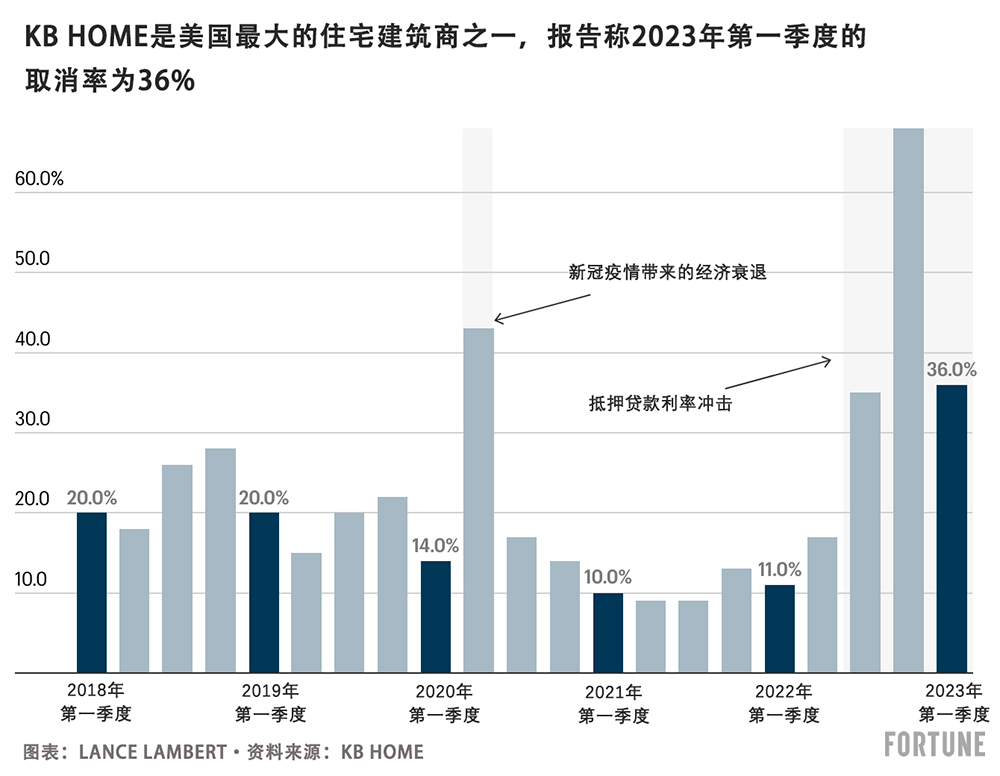美国楼市持续低迷,现已来到关键时刻

2022年9月,美联储(Federal Reserve)的主席杰罗姆·鲍威尔承认,去年的抵押贷款利率冲击将导致美国房地产市场经历“艰难的(房地产)修正”。房屋建筑商的收益表明他的说法是正确的:在2022年第四季度,KB Home的买家取消率飙升至68%。这一数字使这家上市住宅建筑商前一年13%的取消率显得微不足道。这也超过了该行业在2008年金融危机最黑暗时期47%的取消率峰值。
但风暴最糟糕的时候可能已经过去了。至少对建筑商来说是这样。
3月22日,KB Home报告称,2023年第一季度的取消率为36%。一方面,取消购房合同的比率仍然很高。另一方面,这比上季度68%的比率有所下降,这表明建筑商采取的激励措施(例如抵押贷款利率折扣)以及房价下调正在慢慢让购房者回流。
“在本季度进入春季销售旺季时,我们开始看到住房需求增加。这部分反映了我们部署的有针对性的销售策略,以及稳定的抵押贷款利率环境。因此,我们在1月和2月实现了净订单量的连续增加,而且净订单在3月的前几周仍然保持强劲。尽管利率依旧较高,经济仍然存在很大的不确定性,但这一进展让我们备受鼓舞。”KB Home的首席执行官杰弗里·梅茨格尔在3月22日告诉投资者。
在公开上市的住宅建筑商中,KB Home在所谓的房地产修正中受到的打击最大。原因是KB Home的新住宅社区高度集中在过热的西部市场,那里的房价回调尤为剧烈。

为什么KB Home的取消率会下降得如此之快?
具体答案是:在新冠疫情房地产热潮(Pandemic Housing Boom)期间,住房需求似乎是无止境的,像KB Home这样的建筑商在迅速提高新房价格后获得了丰厚的利润。这一点大有裨益:去年房价暴跌,KB Home等建筑商由于之前的积累,赢得了喘息的机会,可以降低利润率(即降价和/或提供给力的抵押贷款利率折扣),以寻找市场,或者等待买家需求恢复后房价上涨。
KB Home的取消率下降表明该建筑商正在“寻找市场”。KB Home并不是唯一一家取消率下降的公司:全美各地的房屋建筑商都看到取消率有所下降。
约翰伯恩斯房地产咨询公司(John Burns Real Estate Consulting)今年2月调查的建筑商的总取消率为10.8%。这远低于2022年10月24.6%的峰值,仅略高于2022年2月新冠疫情房地产热潮时7.3%的峰值。
简而言之:房屋建筑商的取消率正在迅速恢复正常值。

莱纳公司(Lennar)的执行总裁斯图尔特·米勒在今年3月的早些时候对投资者表示:“我们的毛利率下降了……因为我们调整了新房销售和待售房屋的价格,以尽快完成交付并降低取消率。”
通过这些激励措施和降价措施,莱纳公司第一季度房屋销售毛利率从26.9%降至21.2%。
“如今,在大多数情况下,建筑商都不得不采取降价策略。我们认为在全国范围内,新房价格(扣除优惠政策)比峰值下降了约10%。已经没有多少降价空间了。”约翰伯恩斯房地产咨询公司的研究主管小里克·帕拉西奥斯在今年2月发布的一段视频里说。
不像房屋建筑商需要降价以出售未售出的库存,现有房主通常反对采取降价措施。这种阻力就是现房价格通常在房地产市场低迷时最后触底的原因。
“不过,我们仍然认为,在转售方面,(房屋)价格将出现更多的修正。当涉及到(房屋)价格时,转售市场中房价下调粘性较强。”帕拉西奥斯说道。(财富中文网)
译者:中慧言-王芳
2022年9月,美联储(Federal Reserve)的主席杰罗姆·鲍威尔承认,去年的抵押贷款利率冲击将导致美国房地产市场经历“艰难的(房地产)修正”。房屋建筑商的收益表明他的说法是正确的:在2022年第四季度,KB Home的买家取消率飙升至68%。这一数字使这家上市住宅建筑商前一年13%的取消率显得微不足道。这也超过了该行业在2008年金融危机最黑暗时期47%的取消率峰值。
但风暴最糟糕的时候可能已经过去了。至少对建筑商来说是这样。
3月22日,KB Home报告称,2023年第一季度的取消率为36%。一方面,取消购房合同的比率仍然很高。另一方面,这比上季度68%的比率有所下降,这表明建筑商采取的激励措施(例如抵押贷款利率折扣)以及房价下调正在慢慢让购房者回流。
“在本季度进入春季销售旺季时,我们开始看到住房需求增加。这部分反映了我们部署的有针对性的销售策略,以及稳定的抵押贷款利率环境。因此,我们在1月和2月实现了净订单量的连续增加,而且净订单在3月的前几周仍然保持强劲。尽管利率依旧较高,经济仍然存在很大的不确定性,但这一进展让我们备受鼓舞。”KB Home的首席执行官杰弗里·梅茨格尔在3月22日告诉投资者。
在公开上市的住宅建筑商中,KB Home在所谓的房地产修正中受到的打击最大。原因是KB Home的新住宅社区高度集中在过热的西部市场,那里的房价回调尤为剧烈。
为什么KB Home的取消率会下降得如此之快?
具体答案是:在新冠疫情房地产热潮(Pandemic Housing Boom)期间,住房需求似乎是无止境的,像KB Home这样的建筑商在迅速提高新房价格后获得了丰厚的利润。这一点大有裨益:去年房价暴跌,KB Home等建筑商由于之前的积累,赢得了喘息的机会,可以降低利润率(即降价和/或提供给力的抵押贷款利率折扣),以寻找市场,或者等待买家需求恢复后房价上涨。
KB Home的取消率下降表明该建筑商正在“寻找市场”。KB Home并不是唯一一家取消率下降的公司:全美各地的房屋建筑商都看到取消率有所下降。
约翰伯恩斯房地产咨询公司(John Burns Real Estate Consulting)今年2月调查的建筑商的总取消率为10.8%。这远低于2022年10月24.6%的峰值,仅略高于2022年2月新冠疫情房地产热潮时7.3%的峰值。
简而言之:房屋建筑商的取消率正在迅速恢复正常值。
莱纳公司(Lennar)的执行总裁斯图尔特·米勒在今年3月的早些时候对投资者表示:“我们的毛利率下降了……因为我们调整了新房销售和待售房屋的价格,以尽快完成交付并降低取消率。”
通过这些激励措施和降价措施,莱纳公司第一季度房屋销售毛利率从26.9%降至21.2%。
“如今,在大多数情况下,建筑商都不得不采取降价策略。我们认为在全国范围内,新房价格(扣除优惠政策)比峰值下降了约10%。已经没有多少降价空间了。”约翰伯恩斯房地产咨询公司的研究主管小里克·帕拉西奥斯在今年2月发布的一段视频里说。
不像房屋建筑商需要降价以出售未售出的库存,现有房主通常反对采取降价措施。这种阻力就是现房价格通常在房地产市场低迷时最后触底的原因。
“不过,我们仍然认为,在转售方面,(房屋)价格将出现更多的修正。当涉及到(房屋)价格时,转售市场中房价下调粘性较强。”帕拉西奥斯说道。(财富中文网)
译者:中慧言-王芳
In September, Fed Chair Jerome Powell acknowledged that last year’s mortgage rate shock would cause the U.S. housing market to pass through a “difficult [housing] correction.” Homebuilders’ earnings showed he was correct: In the fourth quarter of 2022, KB Home’s buyer cancellation rate spiked to 68%. That figure dwarfed the publicly traded homebuilder’s 13% cancellation rate from the previous year’s period. It also surpassed the industry’s peak cancellation rate of 47% during the darkest days of the 2008-era crash.
But the worst of the storm might be behind us. At least for builders.
On March 22, KB Home reported that its cancellation rate was 36% in the first quarter of 2023. On one hand, that’s still an elevated share of sales under contract being cancelled. On the other hand, it’s a deceleration from the 68% rate last quarter, and a sign that aggressive builder incentives, like mortgage rate buydowns, alongside home price reductions are slowly bringing back buyers.
“As we entered the spring selling season during the quarter, we began to see an increase in [housing] demand. This reflected in part the targeted sales strategies we deployed, together with a stabilizing mortgage interest rate environment. As a result, we achieved a sequential improvement in our net orders in both January and February, and net orders have remained strong in the early weeks of March. Although there are still considerable interest rates and economic uncertainties, we are encouraged by this progression,” Jeffrey Mezger, CEO of KB Home, told investors on March 22.
Among publicly traded homebuilders, KB Home got hit the hardest by the so-called housing correction. The reason being that KB Home has a high concentration of its new home communities in overheated Western markets where the housing correction has been particularly sharp.
Why did KB Home’s cancellation rate drop so quickly?
Here’s the long winded answer: During the Pandemic Housing Boom—a time with seemingly unlimited housing demand—builders like KB Home achieved frothy profit margins as they quickly raised new house prices. That came in handy: As the housing market slumped last year, builders like KB Home had the breathing room to reduce margins (i.e. cutting prices and/or aggressive rate buydowns) in pursuit of finding the market, or the price point at which buyer demand would return.
The drop in KB Home’s cancellation rate suggests the builder is, well, “finding the market.” And the firm isn’t alone: Homebuilders across the country are seeing their cancellation rates improve.
Builders surveyed by John Burns Real Estate Consulting in February had an aggregate cancellation rate of 10.8%. That’s far below the peak of 24.6% hit in October, and just slightly above the 7.3% hit at the height of the Pandemic Housing Boom in February 2022.
Simply put: Homebuilder cancellation rates are normalizing—quickly.
“Our gross margin declined… as we adjusted the price of both our new home sales and homes in [the] backlog to market to promote deliveries and reduce cancellation rates,” Stuart Miller, executive chairman of Lennar, told investors in earlier March.
By offering those incentives and price cuts, Lennar’s first quarter gross profit margin on home sales declined from 26.9% to 21.2%.
“Builders have taken their medicine for the most part right now on pricing. And we think nationally, home prices—on the new-home side, net of incentives—are down about 10% from peak,” Rick Palacios Jr., head of research at John Burns Real Estate Consulting, said in a video posted in February. “There’s probably not a ton of runway there left.”
Unlike homebuilders, who need to cut prices in order to move unsold inventory, existing homeowners are usually more resistant to such cuts. That resistance is why existing-home prices usually bottom out last in a housing market downturn.
“We still think that there’s more [home] price correction to come on the resale side, though. And the resale market is always stickier to the downside when it comes to [home] prices,” says Palacios.













